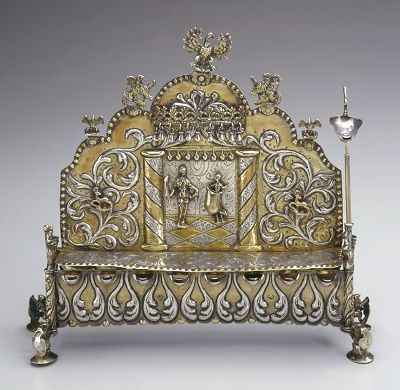 Edit article
Edit articleSeries
Judith: A Chanukah Heroine?

Hanukiah depicting Judith, Italy, 19th century (?) The Jewish Museum, NY.
The Septuagint Book of Judith
We first hear of the heroine in the apocryphal Book of Judith, a Jewish work which has survived in the Septuagint in Greek.[1]In her eponymous book, Judith is a compelling and challenging figure: beautiful and bold, pious and violent, seductive and wise. She does not hesitate to take the initiative in saving her people when the leaders of her besieged city are ready to surrender, reprimanding the leaders for their lack of faith in God (Judith 8:1-36). She also toys with the enemy general Holophernes, using ironic and duplicitous words as well as her extraordinary beauty to lull and then kill him (11:5-19; 12:1-4, 13-18).
We are shown the transformation of Judith from a reclusive and ascetic widow to a glamorous figure who marches into the enemy camp (10:1-17) and seizes the opportunity to kill the drunken Holophernes with his very own sword, when he means to seduce her in his tent (13:1-10). Judith offers her people military advice as well (14:1-4) and celebrates the Israelites’ victory in song (15:8-16:20), only to return to her quiet life at home. When Judith dies at the ripe old age of 105, she is mourned by all of Israel (16:21-25).
The Book of Judith is filled with allusions to biblical figures, phrases, and episodes and Judith herself incorporates many features of biblical women, reminding us, for instance, of Jael killing the vulnerable Sisera in a tent, Deborah exhorting and encouraging Barak, Miriam singing a victory song, and Esther saving her people from the threats of a foreign ruler.
Judith Disappears and Reappears over a Millennium later
Judith’s story disappeared from Jewish tradition fairly early in ancient times and there is no trace of the tale in the Dead Sea Scrolls or in the works of Philo and Josephus. She is not mentioned in the Mishnah, Talmud, or other rabbinic literature, and it is only in the tenth (or perhaps the eleventh) century C.E. onwards, over a thousand years after the apocryphal book was first composed, that Judith is found once again in Jewish literature.
When Judith does re-surface in Jewish circles, it is in a variety of contexts and genres: Hebrew tales of the heroine, liturgical poems or piyyutim, commentaries on the Talmud, and passages in Jewish legal codes.
Judith’s Connection with Chanukah

In these medieval accounts, Judith is often associated with the holiday of Chanukah, an association that likely goes back to the original writing of the book. The apocryphal Book of Judith, generally dated to about 100 BCE, i.e. several decades after the reconsecration of the Temple in 164 BCE by Judah the Maccabee, combines historical elements taken from many periods, including events and figures from Hasmonean times. Thus, the fictitious enemy Nebuchadnezzar, king of the Assyrians (and not the Babylonians!), who desires to be worshipped as a god, seems closely related to the figure of Antiochus IV Epiphanes, while his beheaded general Holophernes whose death leads to the rout of the enemy is reminiscent of the Seleucid general Nicanor whose head is hung in the citadel of Jerusalem by Judah the Maccabee.[2]
Judith herself can be seen as a variation on the figure of Judah (Maccabee), as her very name hints, and in medieval Jewish texts, perhaps as a result of this association, Judith becomes an actual participant in events surrounding the Hasmonean victories.
Purim with Esther, Chanukah with Judith
Another reason for the introduction of Judith into Chanukah tales and customs seems to be the many parallels between Judith and Esther, two beautiful and seductive Jewish heroines who save their people. The two holidays instituted by the rabbis, Chanukah and Purim, are often linked together, and since Purim has a heroine, Esther, and a scroll telling her story, Megillat Esther, this may have led to the analogous holiday, Chanukah, which has no special text of its own, being assigned a similarly brave and beguiling heroine. Indeed, at times, Judith’s story is entitled, Megillat Yehudit, the Scroll of Judith. Thus, even though there is nothing explicit in the text linking Judith with Chanukah, Judith’s tale is frequently enmeshed with the story of Chanukah from medieval times onwards.
Late Judith Midrashim
The Hebrew stories of Judith, often termed the Judith midrashim, are the largest and most varied group of medieval Jewish texts which mention Judith. In these brief and obscure tales – which deserve a much wider audience[3] – Judith again saves her city and people by going to the enemy camp and beheading the intoxicated foreign leader, but in contrast to the apocryphal book, she is often cast as a more vulnerable and dependent figure, a lesser heroine.
At times she is said to be a young, unmarried woman rather than a wealthy and independent widow, and the medieval Judith is often challenged within her own community. When Judith leaves for the enemy camp she is stopped by the guards at the city gate who interrogate her harshly, accusing her of treacherous or promiscuous behavior.
Even more unexpected is the cool reception Judith receives upon her return, for the skeptical guards refuse to believe that the head she carries actually belongs to the enemy commander. These medieval versions seem to reflect their authors’ own era and attitudes.[4]
Biblical Allusions
Language often plays an important part in the Judith midrashim—even more so than in the original apocryphal book. The use of Hebrew allows the authors to produce a text filled with biblical echoes and allusions. Such biblical quotations and paraphrases serve a double function in these tales, both narrating the surface story and pointing subtly to similar biblical scenes and characters which were well known to readers.
Ehud
Thus when Judith echoes the words of the biblical Ehud to King Eglon (Judg 3:19) and says in a medieval tale, “Your Majesty, I have a secret message for you,” דבר סתר לי אליך המלך in order to gain a private audience with the enemy king, readers well understand that her secret message is death.
Subversive Parallel: Delilah
In a more subversive use of biblical material, Judith is implicitly compared to Delilah, for one midrash has Judith hug and kiss the enemy leader and she then “lulled him to sleep on her lap,” ותישנהו על ברכיה (Judg 16:19), the precise expression used to describe Delilah’s action before calling in a man to cut off Samson’s hair.[5]
Ius Primae Noctis and Judah’s Sister Hannah
One group of Hebrew Judith stories is directly linked to Chanukah, and these stories fall into two parts. In the first part, we hear of the assassination of an enemy leader by Hasmoneans, who object to the leader’s desire to exercise his right to sleep with the bride on the first night (ius primae noctis) when their sister is about to be married. Judith, who is now identified as a relative of the Hasmoneans, then beheads a different enemy commander in the second part of these stories.
Often another woman, a member of the Hasmonean family who is generally identified as the sister of Judah Maccabee, plays a critical role in the events preceding Judith’s own activities and the Hasmonean heroine, Hannah, as she is sometimes called, shares Judith’s wisdom and courage. Both women are also found in a liturgical poem or piyyut dated to the early eleventh century, אודך כי אנפת בי (“I give thanks to you although you were angry with me”), by Joseph ben Solomon of Carcassone.
Other liturgical poems telling of the Hasmoneans and Judith were also recited in various Jewish communities on the first and second Shabbat of Chanukah.
Judith in Commentaries on the Talmud and Legal Codes
Although Judith is never mentioned in the Talmud itself, later commentators on the Talmud refer to her, always in the context of Chanukah. These commentators do not tell Judith’s story for its own sake, but use elements of her tale to explain the commandments and customs of the holiday.
Thus the foremost exegete of the Talmud, Rashi (Rabbi Solomon ben Isaac, 1041-1105), when discussing why women, as well as men, are required to light Chanukah candles, simply notes (b. Shabbat 23a),
היו באותו הנס – שגזרו יוונים על כל בתולות הנשואות להיבעל לטפסר תחלה ועל יד אשה נעשה הנס:
They were part of the same miracle – when the Greeks decreed that Jewish virgin brides were to be bedded first by the ruler, a woman brought about the miraculous rescue.

We know that Rashi was acquainted with the liturgical poem “I give thanks” telling of Judith because he quotes it in his biblical commentary (on Ezekiel 21:18), and it is very likely that he knew of her story, but did not choose to mention her by name.
Rashi’s grandson, the Rashbam (Rabbi Samuel ben Meir, 1085-1174), does mention Judith, and he is quoted as saying that the chief miracle of Purim came about through Esther, and that of Chanukah through Judith (Tosafot, b. Megillah 4a).[6]
The Custom to Eat Cheese
Later commentators bring further details. Nissim ben Reuben (ca.1310-1375), known as the Ran, refers to Judith not by name, but as the daughter of Johanan (glosses on Rif, Shabbat 10a). In his account, which he says comes from a midrash, the woman gave the chief enemy cheese to eat so as to make him (thirsty and then) drunk, and then cut off his head. This, adds the Ran, is why it is customary to eat cheese on Chanukah.
In the Kol Bo (section 44), a work outlining Jewish laws and customs dating to the thirteenth or fourteenth century, we find a similar version. In this account, the king of Greece attempts to seduce Judith, the daughter of the high priest Johanan, and she feeds him a cheese dish so that he will become thirsty, drink too much, and fall asleep.
Such references to Judith’s encounter with an enemy whom she fed either cheese or milk – compare Jael! – are subsequently found in a long line of works which codify halakah, and supply the background to the practice of eating cheese dishes on Chanukah.[7] Similar remarks are found in Jewish guides and responsa written to this very day.
Judith: Larger than Life
Judith also appears frequently on Chanukah lamps, with a sword in one hand and Holophernes’ head in the other; at times she appears in the company of figures such as Moses, Aaron, King David, and Judah the Maccabee.[8] Despite her early disappearance from Jewish circles, Judith proved too vital a figure to vanish entirely, and she has left her mark on Jewish texts, prayers, practices, and ritual art.
TheTorah.com is a 501(c)(3) nonprofit organization.
We rely on the support of readers like you. Please support us.
Published
December 4, 2015
|
Last Updated
March 23, 2024
Previous in the Series
Next in the Series
Footnotes

Prof. Deborah Levine Gera is the Shalom Horowitz Professor of Classics at the Hebrew University of Jerusalem. She holds a D. Phil. from Oxford University and an M.A. from the Hebrew University. Her most recent book is Judith (Commentaries on Early Jewish Literature; Berlin: De Gruyter, 2014).
Essays on Related Topics:





